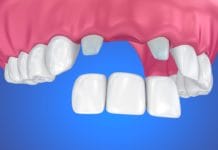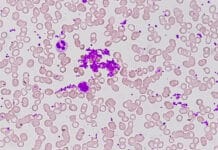A woman goes through many changes during the nine months of pregnancy. It is always exciting to see the first signs of a baby bump, and most moms-to-be are concerned about the health of their growing baby. Unfortunately, these women can be misinformed or not informed at all about how pregnancy can affect oral health and how their oral health can affect their baby.
A study conducted in 2014 found that, although obstetricians generally were knowledgeable about appropriate dental care practices during pregnancy, as well as the relationship between oral health and pregnancy outcomes, this knowledge often did not translate into appropriate practice behavior.1 The following list covers many of the changes in oral health of pregnant patients and will hopefully help in educating these patients for a healthy pregnancy and a healthy baby.
1) Pregnancy Gingivitis
Pregnancy gingivitis may result from hormonal changes that exaggerate the response to bacteria in the periodontal tissue.2 The inflammation of the periodontal tissues due to the formation of biofilm increases dramatically in severity during a normal pregnancy, even without changes in the amount of biofilm present.3 Some studies indicate the reason for the increased inflammation during pregnancy is possibly directly related to the levels of estrogen in the saliva. Estrogen regulates the cellular functions of several tissues which may disturb the host response against bacteria. A study was conducted to evaluate the contribution of estrogen levels in saliva to the severity of gingival inflammation during pregnancy. Salivary estrogen levels increased significantly during the second and third trimesters. In all trimesters and postpartum, the individuals with both high estrogen and high visible plaque index levels had the highest frequency of pregnancygingivitis. During the second and third trimesters, simultaneously enhanced estrogen levels and visible plaque index scores brought an additional risk of developing gingivitis compared with a high visible plaque index score alone.
These findings suggest that, during pregnancy, the estrogen level determines the magnitude of gingival inflammation developed against microbial plaque at the gingival margin.4 Considering the increased risk of pregnancy gingivitis in some pregnant patients, in addition to a thorough review of oral hygiene instructions, more frequent recare appointments may be necessary.
2) Dental Caries
Dental caries risk can be increased during pregnancy. Though many patients believe the increase in caries during pregnancy is due to “the baby taking all their calcium,” we know this is not true. The fetal need for calcium is met by maternal physiological changes, primarily through increased calcium absorption. Intestinal calcium absorption of the mother doubles beginning early in pregnancy, even though there is little calcium transfer to the embryo at this stage and continues through late pregnancy.5
A better explanation for the increase in dental caries during pregnancy is a combination of factors. A study was conducted in 2015 that focused on the measurement of salivary pH during the different trimesters of pregnancy. In this study, a decrease in salivary pH was observed with an increase in caries incidence. A decreased concentration of carbonic anhydrase enzyme (salivary buffer) has been seen to lead to an increased prevalence of caries.6 The cause of the pH shift during pregnancy is attributed to changes in diet such as increased snacking due to cravings, increased acidity in the mouth due to vomiting, dry mouth, or poor oral hygiene stemming from nausea and vomiting.2
Nutritional counseling, along with oral hygiene instructions, could help reduce caries risk in pregnant patients. Topical fluoride treatments at dental appointments would be beneficial as well. Topical fluoride has been assigned to pregnancy category B by the FDA, other well-known drugs found in this category include Acetaminophen and Diphenhydramine. Topical fluoride is not considered a teratogen.7 With all drugs, a need should be established and approval from the treating obstetrician is advised.
3) Pyogenic Granuloma
Pyogenic granuloma is a smooth or lobulated exophytic lesion manifesting as small, red erythematous papules on a pedunculated or sometimes sessile base, which is usually hemorrhagic. The surface ranges from pink to red to purple, depending on the age of the lesion. Although it was originally thought to be caused by pyogenic organisms, it is now believed to be unrelated to infection. Some factors such as nitric oxide synthase, vascular endothelial growth factor, basic fibroblast growth factor, or connective tissue growth factor are known to be involved angiogenesis and rapid growth of pyogenic granuloma.8
Studies have shown an increase in these growth hormones during pregnancy.9,10,11,12 Management of pyogenic granuloma usually depends on the severity of symptoms. If the lesion is small, painless, and free of bleeding, clinical observation and follow up is advised. Conservative surgical excision and removal of causative irritants, such as plaque, calculus, and foreign materials are the usual treatments. Other new approaches for treatment include Nd: YAG laser, flash lamp pulsed dye laser, injection of ethanol or corticosteroids, and sodium tetradecyl sulfate sclerotherapy have been reported as alternative therapies.8
4) Dental Erosion
Dental Erosion stemming from GERD and vomiting due to morning sickness may be detected.2 The increase in intra-abdominal pressure during pregnancy may increase The intrusion of gastric acids into the oral cavity during sleep is especially damaging to the teeth, as salivation and swallowing are reduced, and, in a supine position, the lower molars can be bathed in the acids. Erosion from vomiting is rare, unless the vomiting is chronic, as in the case of hyperemesis gravidarum.13
Dental erosion is irreversible, the focus of erosion is prevention and reduction followed by maintenance. Patients with morning sickness should be encouraged to avoid toothbrushing immediately after vomiting. Instead, they should rinse with a diluted solution of one cup of water and one teaspoon of baking soda to neutralize the acid. Most studies find that milk and yogurt products (presumably unsweetened) can have a protective effect on erosion because of their calcium and phosphate content. Studies have indicated fluoride treatments are effective in protecting dental enamel from the effects of erosion, although efficacy varies according to compound or preparation, and further research is needed.2,13
In general, pregnant women need more information on dental health during pregnancy. With worries about high blood pressure, weight gain, and gestational diabetes, along with a plethora of other complications that could occur during pregnancy, oral health often gets overlooked.
This article discusses how pregnancy can affect your oral health, but there are also many ways your oral health can affect pregnancy. Untreated caries and periodontal disease pose risks to the unborn baby. Some of the concerns associated with oral health include preterm, low birth weight babies and preeclampsia. Studies have been conducted focusing on the oral health knowledge, practices and attitude of pregnant women. The results indicated that only 3% of pregnant women were aware of oral health correlating with adverse pregnancy outcomes.14
Having regular dental checkups during pregnancy is vital. There are many misconceptions about dental care during pregnancy, however, given the implications of poor oral health and its association with adverse pregnancy outcomes, more attention to oral health is necessary for all healthcare professionals who treat pregnant women. I hope this article will reach pregnant women, oral health care professionals, and other healthcare professionals so that collectively we can change this disturbing statistic.
SEE ALSO: Why You Should Discuss Nutrition with Patients to Increase Homecare
DON’T MISS: 10 Expert Tips for Treating Pediatric Dental Patients
Now Check Out the Peer-Reviewed, Self-Study CE Courses from Today’s RDH!
Listen to the Today’s RDH Dental Hygiene Podcast Below:
Resources
- Suri V, Rao NC, Aggarwal N. A study of obstetricians’ knowledge, attitude, and practices in oral health and pregnancy. Educ Health (Abingdon). 2014 Jan-Apr;27(1):51-4. Retrieved from https://www.ncbi.nlm.nih.gov/pubmed/24934944
- American Dental Association retrieved from https://www.ada.org/en/member-center/oral-health-topics/pregnancy
- Silva de Araujo Figueiredo C, Goncalves Carvalho Rosalem C, Costa Cantanhede AL, Abreu Fonseca Thomaz EB, Fontoura Noqueira da Cruz MC. Systemic alterations and their oral manifestation in pregnant women. J Obstet Gynaecol Res. 2017 Jan;43(1):16-22. Retrieved from https://www.ncbi.nlm.nih.gov/pubmed/28074549
- Gursoy M, Gursoy UK, Sorsa T, Pajukanta R, Kononen E. High salivary estrogen and risk of developing pregnancy gingivitis. J Periodontol. 2013 Sep;84(9):1281-9. Retrieved from https://www.ncbi.nlm.nih.gov/pubmed/23237582
- Kovacs CS. Calcium metabolism during pregnancy and lactation. Retrieved from https://www.ncbi.nlm.nih.gov/books/NBK279173/
- Kanu Jain, Harshaminder Kaur. Prevelance of oral lesions and measurement of salivary pH in the different trimesters of pregnancy. Singapore Med J v.56(1); 2015 Jan. Retrieved from https://www.ncbi.nlm.nih.gov/pmc/articles/PMC4325572/
- Drugs.com Retrieved from https://www.drugs.com/pregnancy/fluoride-topical.html
- Jafarzadeh H, Sanatkhani M, Mohtasham N. Oral Pyogenic Granuloma: A Review. J. Oral Sci 2006 Dec;48(4):167-75. Retrieved from https://www.ncbi.nlm.nih.gov/pubmed/17220613
- Evans P, Wheeler T, Anthony F, Osmond C. Maternal serum vascular endothelial growth factor during early pregnancy. Clin Sci (Lond) 1997 Jun;92(6):567-71. Retrieved from https://www.ncbi.nlm.nih.gov/pubmed/9205416
- Ledingham MA, Thomson AJ, Young A, Macara LM, Greer IA, Norman JE. Changes in expression of nitric oxide synthase in human uterine cervix during pregnancy and parturition. Mol Hum Reprod. 2000 Nov;6(11):1041-8. Retrieved from https://www.ncbi.nlm.nih.gov/pubmed/11044468
- Zheng J, Vagnoni KE, Bird IM, Magness RR. Expression of basic fibroblast growth factor, endothelial mitogenic activity, and angiotensin II type-1 receptors in ovine placenta during the third trimester of pregnancy. Biol Reprod. 1997 May;56(5):1189-97. Retrieved from https://www.ncbi.nlm.nih.gov/pubmed/9160718
- Pasek RC, Dunn JC, Elsakr JM, Aramandla M, Matta AR, Gannon M. Vascular-derived connective tissue growth factor is critical for pregnancy-induced B cell hyperplasia in adult mice. Islets. 2017 Nov 2;9(6):150-158. Retrieved from https://www.ncbi.nlm.nih.gov/pubmed/29111856
- American Dental Association. Retrieved from https://www.ada.org/en/member-center/oral-health-topics/dental-erosion
- Gupta S, Jain A, Mohan S, Bhaskar N, Walia PK. Comparative Evaluation of Oral Health Knowledge, Practices and Attitude of Pregnant and Non-Pregnant Women, and Their Awareness Regarding Adverse Pregnancy Outcomes. J Clin Diagn Res. 2015 Nov;9(11):26-32. Retrieved from https://www.ncbi.nlm.nih.gov/pubmed/26674176










